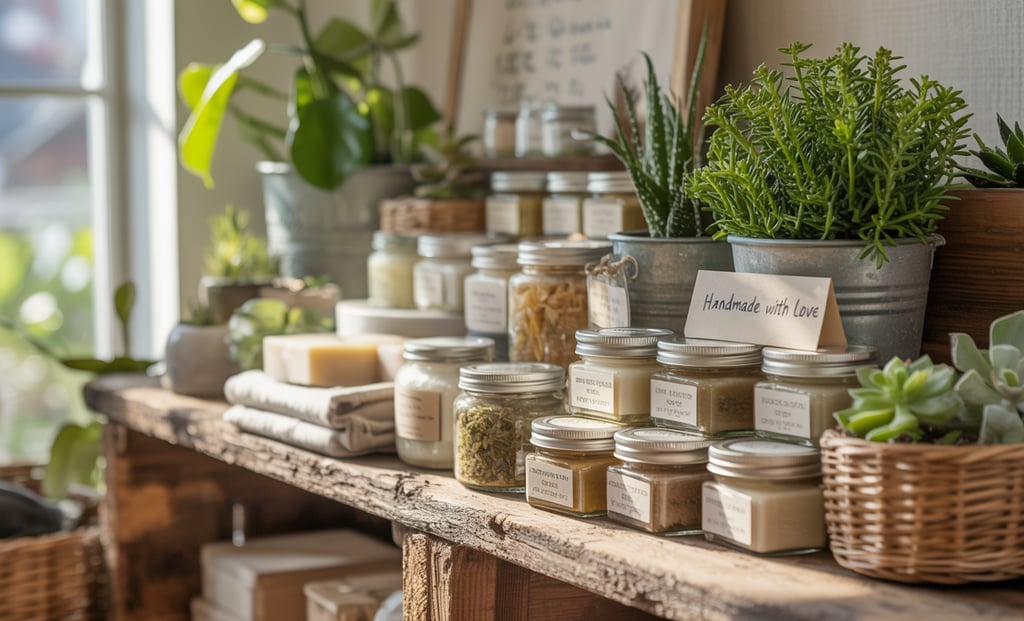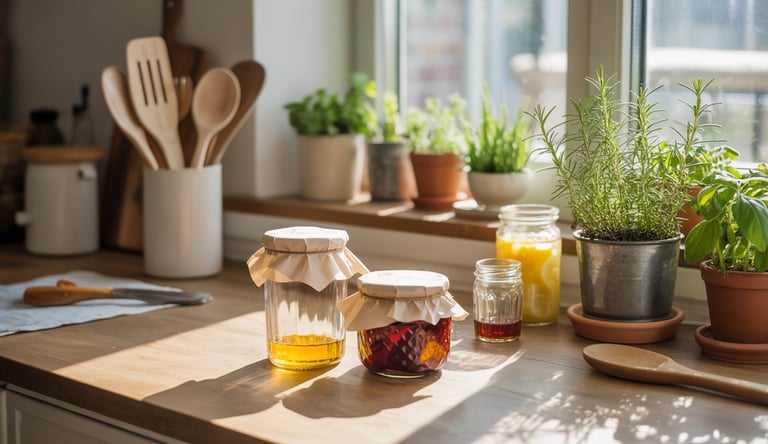Discover Eco-Friendly Products for a Greener Lifestyle
Who says sustainability can’t be stylish? Discover products that elevate your space and protect the planet.
SELF-CARE AND WELLNESSHOME DECOR
FONNI
8/6/202511 min read


The content on this site was created with the help of AI. LOVEOWE LLC participates in the Amazon Services LLC Associates Program and other affiliate programs. As an Amazon Associate, I earn from qualifying purchases. This means I may earn a small commission—at no extra cost to you—when you make a purchase through links on this site. All opinions are my own. Learn more click here. Thank you for your support!
In our quest for a sustainable lifestyle, we seek ways to lessen our environmental impact. EarthHero, a champion of sustainability, reveals that 64% of consumers now prioritize sustainability. This growing demand for eco-friendly options empowers us to make a positive change.
Adopting sustainable goods in our daily routines benefits both our health and the planet. It's about choosing wisely, aligning our actions with our values. As we delve into green living essentials, we'll uncover how these small steps can collectively make a big impact.
The Environmental Impact of Conventional Products
Our daily choices, including the products we buy, play a crucial role in shaping the future of our environment. As we go about our daily lives, it's easy to overlook the impact of conventional products on our planet.
Understanding Your Carbon Footprint
Every product we use has a carbon footprint, from production to disposal. By understanding the size of our carbon footprint, we can begin to make changes that reduce our environmental impact.
How Everyday Items Affect Our Planet
Everyday items, such as plastic bags, water bottles, and cleaning supplies, contribute to pollution and waste. Here are a few examples:
Single-use plastics end up in oceans and harm marine life.
Chemicals from cleaning supplies can contaminate waterways.
Non-biodegradable waste accumulates in landfills.
The Urgency of Sustainable Choices
Making sustainable choices is no longer a choice but a necessity. By switching to environmentally friendly products, eco-conscious items, and earth-friendly products, we can significantly reduce our environmental footprint.
As we move forward, it's essential to prioritize sustainable living and make conscious choices that support a greener lifestyle.
Essential Eco-Friendly Products for Sustainable Living
Our quest for sustainable living demands we pinpoint eco-friendly products that significantly impact our environment. With numerous choices, discerning which are truly sustainable can be daunting.
Defining True Sustainability in Products
True sustainability transcends mere eco-friendliness. It involves the use of renewable resources, minimal environmental footprint, and ethical production methods.
Key Certifications and Labels to Trust
For informed purchasing, we must seek out products with verifiable certifications. Look for these labels:
Ratings from Energy Star and EPEAT for electronics
Forest Stewardship Council (FSC) Certification for wood and paper products
USDA Organic and Fair Trade Labels for agricultural products
Energy Star and EPEAT Ratings
Energy Star and EPEAT ratings are vital for gauging the energy efficiency and environmental footprint of electronic devices.
Forest Stewardship Council (FSC) Certification
FSC certification verifies that wood and paper products originate from sustainably managed forests.
USDA Organic and Fair Trade Labels
USDA Organic and Fair Trade labels confirm products are crafted with organic components and produced under equitable labor conditions.
How to Avoid Greenwashing When Shopping
Greenwashing poses a significant challenge in the quest for eco-friendly products. To sidestep it, follow these steps:
Seek out specific certifications and labels
Investigate the company's commitment to sustainability
Be cautious of ambiguous environmental claims
Transforming Your Kitchen with Green Alternatives
Adopting green alternatives in your kitchen is a step towards a more sustainable lifestyle. Simple changes can significantly reduce your kitchen's environmental impact. We'll explore practical ways to replace conventional products with eco-friendly ones, making your kitchen healthier for you and the planet.
Replacing Plastic Food Storage
One of the easiest ways to make your kitchen more eco-friendly is by replacing plastic food storage containers. Plastic waste is a significant environmental issue. Switching to alternative storage solutions can make a big difference.
Glass Container Systems: Glass containers are durable, non-toxic, and can be used for both storing food and cooking. They are a great alternative to plastic containers and can be easily recycled.
Beeswax and Silicone Wraps: Beeswax wraps are a natural, reusable alternative to plastic wrap for covering bowls and wrapping snacks. Silicone wraps are also reusable and can be used for wrapping food or covering containers.
Sustainable Cookware Options
Choosing the right cookware can also contribute to a more sustainable kitchen. Some materials are more eco-friendly than others, offering durability and performance.
Cast Iron and Stainless Steel Benefits: Cast iron cookware is incredibly durable and can last for decades with proper care. Stainless steel cookware is also long-lasting and resistant to scratches and corrosion.
Bamboo and Wooden Utensils: Bamboo and wooden utensils are sustainable alternatives to plastic utensils. They are biodegradable and can be sourced from renewable resources.
Eco-Friendly Cleaning Solutions
Cleaning your kitchen with eco-friendly products is another way to reduce your environmental footprint. You can either make your own cleaning solutions or choose commercial products that are biodegradable.
DIY Cleaning Products: Making your own cleaning products using natural ingredients like vinegar, baking soda, and lemon juice is cost-effective and reduces packaging waste.
Biodegradable Commercial Options: If you prefer to buy cleaning products, look for brands that offer biodegradable and non-toxic formulas. These products are gentler on the environment and your kitchen surfaces.
By implementing these green alternatives in your kitchen, you'll not only reduce your environmental impact but also create a healthier cooking space. Start with small changes and gradually move towards a more sustainable kitchen.
Creating an Eco-Conscious Bathroom
Starting an eco-conscious lifestyle begins in the bathroom, with choices that make a big difference. We can make our daily routines more sustainable by focusing on the bathroom. It's full of opportunities for improvement.
Plastic-Free Personal Care
Switching to plastic-free personal care products is a simple way to make your bathroom greener. Solid shampoo bars and bamboo toothbrushes are becoming popular for their eco-friendly benefits.
Solid Shampoo and Conditioner Bars
Solid shampoo and conditioner bars cut down on plastic waste. They eliminate the need for plastic bottles, reducing packaging.
Bamboo Toothbrushes and Dental Floss
Bamboo toothbrushes are a sustainable alternative to plastic ones. Using dental floss in reusable containers also cuts down on plastic waste.
Water Conservation Fixtures
Conserving water is key, and the right fixtures can help a lot.
Low-Flow Showerheads and Faucet Aerators
Low-flow showerheads and faucet aerators save water without losing pressure. They're a smart choice for saving water.
Dual-Flush Toilet Converters
Dual-flush toilet converters give you more control over water use. They significantly reduce water waste.
Sustainable Towels and Linens
Choosing sustainable materials for towels and linens is another step towards an eco-friendly bathroom.
Organic Cotton and Hemp Options
Organic cotton and hemp are great for towels and linens. They're durable and sustainable.
Proper Care for Longevity
Proper care, like washing in cold water and avoiding fabric softeners, can make your towels and linens last longer.
By making these changes, you can greatly reduce your bathroom's environmental impact. This contributes to a more sustainable lifestyle.
Building a Sustainable Wardrobe
The fashion industry is a major polluter, making sustainable choices crucial. We can drive change by making informed decisions about our clothing. This includes what we buy, wear, and discard.
Ethical Clothing Materials and Brands
Choosing the right materials is key in sustainable fashion. Brands are now focusing on materials with lower environmental impact.
Organic Cotton, Hemp, and Tencel
These materials are becoming more popular for their sustainability. Organic cotton is grown without harmful pesticides or synthetic fertilizers. Hemp is durable, needing less water and pesticides. Tencel, from wood pulp, is breathable and biodegradable.
Organic cotton reduces environmental harm from pesticides and fertilizers.
Hemp is durable, needing minimal water and pesticides.
Tencel is breathable and biodegradable, making it sustainable.
Recycled Polyester and Nylon
Using recycled materials in clothing reduces waste and conserves resources. Many brands use recycled polyester and nylon for sustainable clothing.
Reduces landfill waste by reusing plastic materials.
Decreases the need for new raw materials.
Often has a lower carbon footprint than producing new polyester and nylon.
Extending Garment Lifespan
Extending your garments' life is a great way to make your wardrobe more sustainable.
Repair and Upcycling Techniques
Simple repairs can greatly extend a garment's life. Upcycling old clothes into new items is also a creative way to refresh your wardrobe without buying new.
Learn basic repair techniques like fixing buttons and patching tears.
Get creative with upcycling old clothes into new items like bags or scarves.
Proper Washing and Storage
Proper washing and storage can affect your clothes' longevity. Gentle washing cycles and air drying can reduce wear and tear.
Wash clothes in cold water to save energy and reduce fading.
Store clothes properly to prevent wrinkles and damage.
Eco-Friendly Laundry Practices
Adopting eco-friendly laundry practices can significantly reduce your environmental impact.
Natural Detergents and Stain Removers
Switching to natural detergents and stain removers can reduce chemical use. Look for products that are free from harsh chemicals and better for the environment.
Choose detergents that are biodegradable and free from phosphates.
Opt for stain removers that use natural ingredients.
Energy-Efficient Washing Methods
Washing clothes in cold water and using energy-efficient washing machines can make a big difference.
Wash full loads to maximize efficiency.
Consider using a washing machine with a high energy star rating.
Setting Up an Eco-Friendly Home Office
With more time spent working from home, setting up an eco-friendly home office is crucial. Simple changes can greatly reduce our environmental impact and create a healthier workspace.
Energy-Efficient Electronics
Creating an eco-friendly home office starts with energy-efficient electronics.
Selecting Low-Energy Devices
Seek out devices with low energy consumption ratings. Opt for LED monitors and energy-efficient printers.
Power Management Strategies
Use power-saving strategies like turning off devices when not in use. Smart power strips can also eliminate standby power consumption.
Sustainable Office Supplies
Switching to sustainable office supplies is another effective way to make your home office eco-friendly.
Recycled Paper and Notebooks
Choose notebooks and paper made from recycled materials. This reduces the demand for virgin wood pulp and minimizes waste.
Refillable Pens and Non-Toxic Markers
Opt for refillable pens and markers with non-toxic inks. This reduces plastic waste and ensures a healthier workspace.
Reducing Digital Carbon Footprint
In today's digital age, addressing our digital carbon footprint is essential.
Cloud Storage Optimization
Optimize your cloud storage by regularly cleaning up unnecessary files. Choose eco-friendly cloud storage providers.
Email and File Management
Practice efficient email and file management. Unsubscribe from unnecessary newsletters and organize your digital files.
By implementing these strategies, you can create a sustainable and eco-friendly home office. This contributes to a greener future.
Zero-Waste Household Essentials
Transforming your home into a zero-waste haven begins with essential items. Making conscious choices to reduce our environmental footprint is crucial. Focus on products and practices with significant impacts.
Composting Systems for Any Space
Composting is vital for reducing household waste. It decreases landfill waste and creates nutrient-rich soil for gardens.
Countertop Composters for Apartments
Countertop composters are a breakthrough for apartment dwellers. They are compact, odor-controlled, and simplify composting in small spaces.
Backyard Composting Methods
Backyard composting offers various methods, like bins or piles. These allow for larger compost quantities, fitting your space and needs.
Reusable Alternatives to Disposables
Switching to reusable products from disposables is effective. Simple changes can significantly reduce waste.
Cloth Napkins and Towels
Replacing paper napkins and towels with cloth alternatives is easy. They are washable, reusable, and can be made from sustainable materials.
Silicone Food Bags and Covers
Silicone food bags and covers are durable and reusable alternatives to plastic wrap. They are easy to clean and versatile for food storage.
Smart Shopping Strategies
Adopting smart shopping strategies is crucial for a zero-waste home. Being mindful of packaging and choosing products wisely reduces waste.
Bulk Buying with Reusable Containers
Buying in bulk with reusable containers reduces packaging waste. It allows for exact purchases, avoiding excess packaging.
Package-Free Store Options
Shopping at package-free stores is another strategy. These stores offer products like nuts, grains, and cleaning supplies without packaging, encouraging customers to bring their containers.
By implementing these strategies and making simple changes, you can significantly reduce household waste. This contributes to a more sustainable lifestyle.
Eco-Friendly Products for Outdoor and Garden
Our gardens and outdoor spaces are perfect for embracing eco-friendly practices. By selecting the right products, we can create a sustainable haven. This not only beautifies our surroundings but also benefits the planet.
Sustainable Gardening Tools
Gardening is a therapeutic activity that connects us with nature. To enhance its sustainability, we can choose durable, ethically-made tools and solar-powered accessories.
Durable, Ethically-Made Equipment
Investing in high-quality, long-lasting gardening tools reduces waste and supports ethical manufacturing. Choose brands that prioritize sustainability and fair labor practices.
Solar-Powered Garden Accessories
Solar-powered accessories, like garden lights and irrigation controllers, reduce our reliance on non-renewable energy. They also add a modern touch to our gardens.
Organic Growing Supplies
For an eco-friendly garden, focus on organic growing supplies. This includes heirloom seeds, organic soil, and natural fertilizers and pest control methods.
Heirloom Seeds and Organic Soil
Heirloom seeds preserve biodiversity and connect us to our gardening heritage. Combined with organic soil, they provide a healthy base for our plants.
Natural Fertilizers and Pest Control
Using natural fertilizers and pest control methods keeps our gardens chemical-free. This promotes a healthy ecosystem.
Water Conservation Systems
Water conservation is crucial. Implementing rain barrels, drip irrigation, and soaker hoses can significantly reduce water waste.
Rain Barrels and Collection Methods
Rain barrels collect rainwater for later use, reducing municipal water demand. This simple practice can make a significant difference.
Drip Irrigation and Soaker Hoses
Drip irrigation and soaker hoses deliver water directly to plant roots, minimizing evaporation and runoff. These systems are efficient and easy to install.
By incorporating these eco-friendly products into our outdoor and garden spaces, we can enjoy a more sustainable lifestyle. This contributes to a healthier planet.
Green Travel and Transportation Items
Adopting eco-friendly travel and transportation is a key step towards lessening our environmental impact. As we grow more aware of our ecological footprint, it's vital to make sustainable travel choices. This is essential for the health of our planet.
Sustainable Travel Essentials
To travel sustainably, we must reassess our travel essentials. Simple yet impactful changes include using reusable water bottles and coffee cups, and opting for plastic-free toiletry kits.
Reusable Water Bottles and Coffee Cups
Choose durable, BPA-free water bottles that can withstand various temperatures.
Opt for coffee cups made from sustainable materials like bamboo or recycled stainless steel.
Plastic-Free Toiletry Kits
Choosing plastic-free toiletry kits is another eco-conscious decision. Look for kits with refillable containers or those crafted from biodegradable materials.
Eco-Friendly Transportation Tools
Eco-friendly transportation is crucial for green travel. This encompasses using bicycle accessories and maintenance for a smoother ride, and investing in electric vehicle charging solutions.
Bicycle Accessories and Maintenance
Regular maintenance ensures your bicycle is in good condition.
Accessories like panniers and baskets made from sustainable materials can enhance your cycling experience.
Electric Vehicle Charging Solutions
For those driving electric vehicles, installing home charging stations or using public charging points can make a significant difference.
Reducing Travel Impact
Beyond our travel and transportation choices, we can further reduce our impact. This includes considering carbon offset programs and choosing sustainable accommodations.
Carbon Offset Programs
Carbon offset programs allow us to compensate for our emissions by investing in environmental projects. This can be a meaningful step towards neutralizing our travel footprint.
Sustainable Accommodation Choices
Opt for hotels or lodges that have implemented sustainable practices.
Consider eco-lodges or environmentally certified accommodations.
Measuring and Improving Your Eco-Friendly Lifestyle
Our journey towards a greener lifestyle demands constant evaluation and refinement. It's crucial to track our progress and pinpoint areas for enhancement. This way, we can fine-tune our habits and make better choices regarding eco products and green products.
Tools for Tracking Environmental Impact
Effective tools are essential for monitoring and reducing our environmental footprint. Two indispensable resources are:
Carbon Footprint Calculators
These tools reveal the environmental impact of our daily actions. They offer insights into how we can make more eco-friendly choices.
Water and Energy Usage Monitors
Monitoring our water and energy use helps us spot opportunities to save these precious resources.
Creating Sustainable Habits
Building sustainable habits is key to long-term environmental care. Effective strategies include:
30-Day Challenges and Trackers
Participating in 30-day challenges can help us establish new habits and monitor our advancement.
Family and Community Involvement
Involving our families and communities in sustainability efforts can significantly increase our impact. It also fosters a collective sense of responsibility.
Continuous Improvement Strategies
Ensuring ongoing progress requires regular evaluation and adaptation of our strategies. This involves:
Seasonal Audits and Adjustments
Seasonal audits enable us to assess our progress and adjust our sustainable practices and goods as needed.
By employing these tools and strategies, we can continually enhance our eco-friendly lifestyle. This contributes significantly to a more sustainable future.
Conclusion: Embracing a Greener Future Through Conscious Choices
Our path towards a sustainable lifestyle is shaped by the choices we make. These choices significantly impact our environment. By integrating eco-friendly products and sustainable goods into our daily routines, we fuel demand for green living essentials. This supports a healthier planet for all.
Every decision we make can contribute to a greener future. Opting for products designed with sustainability in mind is crucial. This includes choosing reusable alternatives and eco-friendly cleaning solutions. As we embrace sustainable practices, we enhance our lives and contribute to a larger movement.
Let's keep making choices that support a sustainable world. Doing so empowers us and our communities to live in harmony with the environment. Together, we can create a greener future.


